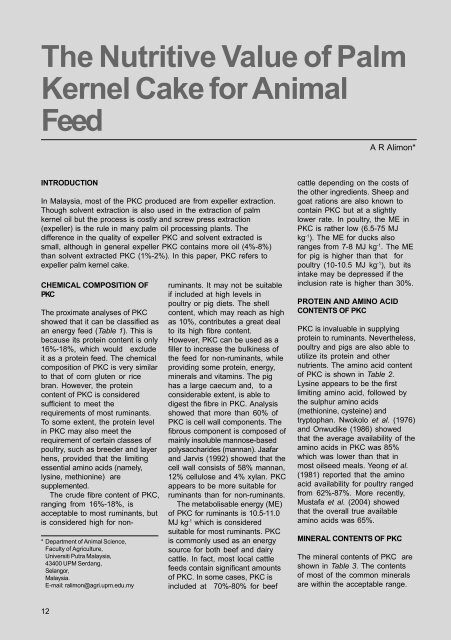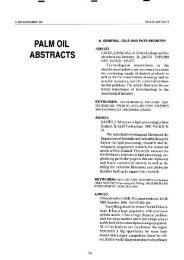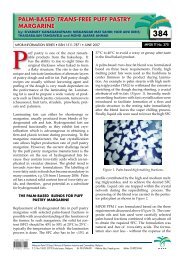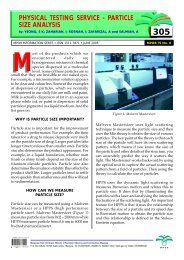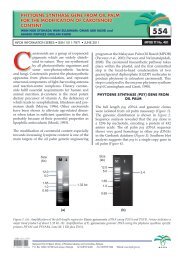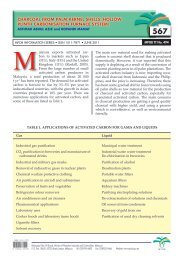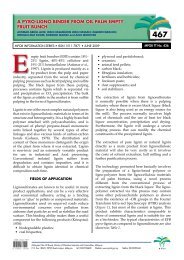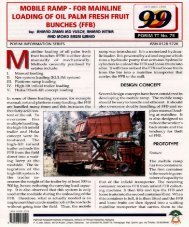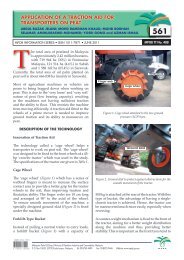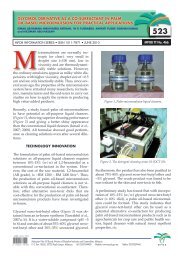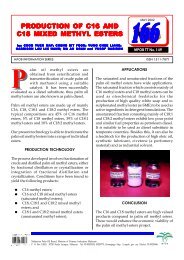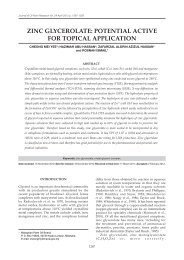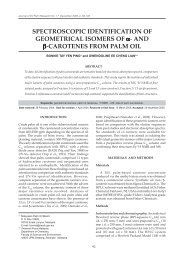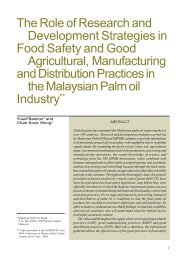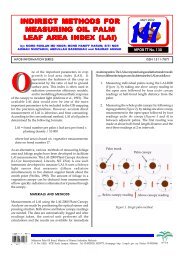The Nutritive Value of Palm Kernel Cake for Animal Feed
The Nutritive Value of Palm Kernel Cake for Animal Feed
The Nutritive Value of Palm Kernel Cake for Animal Feed
You also want an ePaper? Increase the reach of your titles
YUMPU automatically turns print PDFs into web optimized ePapers that Google loves.
<strong>The</strong> <strong>Nutritive</strong> <strong>Value</strong> <strong>of</strong> <strong>Palm</strong><br />
<strong>Kernel</strong> <strong>Cake</strong> <strong>for</strong> <strong>Animal</strong><br />
<strong>Feed</strong><br />
INTRODUCTION<br />
In Malaysia, most <strong>of</strong> the PKC produced are from expeller extraction.<br />
Though solvent extraction is also used in the extraction <strong>of</strong> palm<br />
kernel oil but the process is costly and screw press extraction<br />
(expeller) is the rule in many palm oil processing plants. <strong>The</strong><br />
difference in the quality <strong>of</strong> expeller PKC and solvent extracted is<br />
small, although in general expeller PKC contains more oil (4%-8%)<br />
than solvent extracted PKC (1%-2%). In this paper, PKC refers to<br />
expeller palm kernel cake.<br />
CHEMICAL COMPOSITION OF<br />
PKC<br />
<strong>The</strong> proximate analyses <strong>of</strong> PKC<br />
showed that it can be classified as<br />
an energy feed (Table 1). This is<br />
because its protein content is only<br />
16%-18%, which would exclude<br />
it as a protein feed. <strong>The</strong> chemical<br />
composition <strong>of</strong> PKC is very similar<br />
to that <strong>of</strong> corn gluten or rice<br />
bran. However, the protein<br />
content <strong>of</strong> PKC is considered<br />
sufficient to meet the<br />
requirements <strong>of</strong> most ruminants.<br />
To some extent, the protein level<br />
in PKC may also meet the<br />
requirement <strong>of</strong> certain classes <strong>of</strong><br />
poultry, such as breeder and layer<br />
hens, provided that the limiting<br />
essential amino acids (namely,<br />
lysine, methionine) are<br />
supplemented.<br />
<strong>The</strong> crude fibre content <strong>of</strong> PKC,<br />
ranging from 16%-18%, is<br />
acceptable to most ruminants, but<br />
is considered high <strong>for</strong> non-<br />
* Department <strong>of</strong> <strong>Animal</strong> Science,<br />
Faculty <strong>of</strong> Agriculture,<br />
Universiti Putra Malaysia,<br />
43400 UPM Serdang,<br />
Selangor,<br />
Malaysia.<br />
E-mail: ralimon@agri.upm.edu.my<br />
12<br />
ruminants. It may not be suitable<br />
if included at high levels in<br />
poultry or pig diets. <strong>The</strong> shell<br />
content, which may reach as high<br />
as 10%, contributes a great deal<br />
to its high fibre content.<br />
However, PKC can be used as a<br />
filler to increase the bulkiness <strong>of</strong><br />
the feed <strong>for</strong> non-ruminants, while<br />
providing some protein, energy,<br />
minerals and vitamins. <strong>The</strong> pig<br />
has a large caecum and, to a<br />
considerable extent, is able to<br />
digest the fibre in PKC. Analysis<br />
showed that more than 60% <strong>of</strong><br />
PKC is cell wall components. <strong>The</strong><br />
fibrous component is composed <strong>of</strong><br />
mainly insoluble mannose-based<br />
polysaccharides (mannan). Jaafar<br />
and Jarvis (1992) showed that the<br />
cell wall consists <strong>of</strong> 58% mannan,<br />
12% cellulose and 4% xylan. PKC<br />
appears to be more suitable <strong>for</strong><br />
ruminants than <strong>for</strong> non-ruminants.<br />
<strong>The</strong> metabolisable energy (ME)<br />
<strong>of</strong> PKC <strong>for</strong> ruminants is 10.5-11.0<br />
MJ kg -1 which is considered<br />
suitable <strong>for</strong> most ruminants. PKC<br />
is commonly used as an energy<br />
source <strong>for</strong> both beef and dairy<br />
cattle. In fact, most local cattle<br />
feeds contain significant amounts<br />
<strong>of</strong> PKC. In some cases, PKC is<br />
included at 70%-80% <strong>for</strong> beef<br />
A R Alimon*<br />
cattle depending on the costs <strong>of</strong><br />
the other ingredients. Sheep and<br />
goat rations are also known to<br />
contain PKC but at a slightly<br />
lower rate. In poultry, the ME in<br />
PKC is rather low (6.5-75 MJ<br />
kg -1 ). <strong>The</strong> ME <strong>for</strong> ducks also<br />
ranges from 7-8 MJ kg -1 . <strong>The</strong> ME<br />
<strong>for</strong> pig is higher than that <strong>for</strong><br />
poultry (10-10.5 MJ kg -1 ), but its<br />
intake may be depressed if the<br />
inclusion rate is higher than 30%.<br />
PROTEIN AND AMINO ACID<br />
CONTENTS OF PKC<br />
PKC is invaluable in supplying<br />
protein to ruminants. Nevertheless,<br />
poultry and pigs are also able to<br />
utilize its protein and other<br />
nutrients. <strong>The</strong> amino acid content<br />
<strong>of</strong> PKC is shown in Table 2.<br />
Lysine appears to be the first<br />
limiting amino acid, followed by<br />
the sulphur amino acids<br />
(methionine, cysteine) and<br />
tryptophan. Nwokolo et al. (1976)<br />
and Onwudike (1986) showed<br />
that the average availability <strong>of</strong> the<br />
amino acids in PKC was 85%<br />
which was lower than that in<br />
most oilseed meals. Yeong et al.<br />
(1981) reported that the amino<br />
acid availability <strong>for</strong> poultry ranged<br />
from 62%-87%. More recently,<br />
Mustafa et al. (2004) showed<br />
that the overall true available<br />
amino acids was 65%.<br />
MINERAL CONTENTS OF PKC<br />
<strong>The</strong> mineral contents <strong>of</strong> PKC are<br />
shown in Table 3. <strong>The</strong> contents<br />
<strong>of</strong> most <strong>of</strong> the common minerals<br />
are within the acceptable range.
TABLE 1. PROXIMATE ANALYSIS (%) OF PALM KERNEL CAKE<br />
Dry matter 88.0 – 94.5<br />
Crude protein 14.5 – 19.6<br />
Crude fibre 13.0 – 20.0<br />
Ether extract 5.0 – 8.0<br />
Ash 3.0 – 12.0<br />
Nitrogen-free extract 46.7 – 58.8<br />
Neutral detergent fibre 66.8 – 78.9<br />
Metabolisable energy (MJ kg -1 )<br />
Ruminants 10.5 – 11.5<br />
Poultry 6.5 – 7.5<br />
Swine 10.0 – 10.5<br />
TABLE 2. AMINO ACID CONTENTS OF PALM KERNEL CAKE (g/16 g N)<br />
Alanine 3.83<br />
Arginine 11.56<br />
Aspartic acid 3.63<br />
Cystine 1.13<br />
Glycine 4.17<br />
Glutamic acid 16.80<br />
Histidine 1.91<br />
Isoleucine 3.22<br />
Leucine 6.07<br />
Lysine 2.68<br />
Methionine 1.75<br />
Phenylalanine 3.96<br />
Proline 3.31<br />
Serine 4.11<br />
Threonine 2.75<br />
Tyrosine 2.60<br />
Valine 5.05<br />
TABLE 3. MINERAL CONTENTS OF PALM KERNEL CAKE<br />
Calcium (%) 0.21 – 0.34<br />
Phosphorus (%) 0.48 – 0.71<br />
Magnesium (%) 0.16 – 0.33<br />
Potassium (%) 0.76 – 0.93<br />
Sulphur (%) 0.19 – 0.23<br />
Copper (ppm) 20.5 – 28.9<br />
Zinc (ppm) 40.5 – 50.0<br />
Iron (ppm) 835 – 6130<br />
Manganese (ppm) 132 – 340<br />
Molybdenum (ppm) 0.70 – 0.79<br />
Selenium (ppm) 0.23 – 0.30<br />
However, the ratio <strong>of</strong> calcium to<br />
phosphorus is low and diets based<br />
on PKC need to be supplemented<br />
with calcium to meet the<br />
requirements <strong>of</strong> most animals. <strong>The</strong><br />
copper content <strong>of</strong> 21-28 ppm is<br />
higher than that required by<br />
ruminants. In fact, sheep fed diets<br />
containing PKC above 50% may<br />
suffer high accumulation <strong>of</strong><br />
copper in the liver if fed too long<br />
and develop copper toxicity<br />
symptoms. Studies on the<br />
relationship between copper<br />
toxicity and the feeding <strong>of</strong> PKC<br />
to sheep have been conducted by<br />
many workers (Hair-Bejo et al.,<br />
<strong>The</strong> <strong>Nutritive</strong> <strong>Value</strong> <strong>of</strong> <strong>Palm</strong> <strong>Kernel</strong> <strong>Cake</strong> <strong>for</strong> <strong>Animal</strong> <strong>Feed</strong><br />
1995; Alimon and Hair-Bejo,<br />
1995). Malaysian indigenous<br />
sheep and their crosses were more<br />
susceptible to copper toxicity than<br />
exotic breeds. Al-Kirshi (2004)<br />
showed that Santa Innes hair<br />
sheep were more tolerant <strong>of</strong><br />
copper than Malaysian indigenous<br />
sheep. In their studies, Santa<br />
Innes sheep fed PKC-based diets<br />
did not show physical symptoms<br />
<strong>of</strong> copper toxicity in spite <strong>of</strong><br />
being fed <strong>for</strong> more than six<br />
months. <strong>The</strong> study also showed<br />
that both molybdenum and<br />
sulphur are effective in reducing<br />
the copper levels in the liver and<br />
kidneys <strong>of</strong> sheep fed PKC-based<br />
diets. Earlier, Hair-Bejo et al.<br />
(1995) showed that zinc sulphate<br />
can be used instead <strong>of</strong><br />
molybdenum and sulphur. <strong>The</strong><br />
iron content <strong>of</strong> PKC is also high<br />
but does not adversely affect the<br />
animal per<strong>for</strong>mance as most<br />
ruminants are able to regulate<br />
their iron absorption.<br />
DIGESTIBILITY OF NUTRIENTS IN<br />
PKC<br />
Table 4 shows the digestibility<br />
coefficient <strong>of</strong> nutrients in PKC by<br />
sheep and cattle. <strong>The</strong> digestibility<br />
values <strong>for</strong> ADF and NDF are<br />
much higher in cattle than in<br />
sheep, suggesting that sheep is<br />
less efficient than cattle in the<br />
digesting fibre. <strong>The</strong> digestible<br />
energy (ME) <strong>of</strong> PKC in sheep and<br />
cattle is similar to those <strong>of</strong> many<br />
feedstuffs <strong>of</strong> cereal origin. <strong>The</strong> ME<br />
<strong>for</strong> sheep (12.35 MJ kg -1 ) appears<br />
to be much higher than that <strong>for</strong><br />
cattle (10.96 MJ kg -1 ) as reported<br />
by Wong and Wan Zahari (1997).<br />
In sheep fed PKC- based diets,<br />
Al-Kirshi (2004) showed that the<br />
apparent absorption <strong>of</strong> calcium,<br />
magnesium, iron, zinc and<br />
manganese were not significantly<br />
different between the diets but<br />
that these were significantly lower<br />
in PKC diets supplemented with<br />
molybdenum, molybedenum plus<br />
sulphur or zinc suggesting that<br />
these supplements are suitable <strong>for</strong><br />
alleviating copper toxicity.<br />
13
<strong>Palm</strong> Oil Developments 40<br />
CONCLUSION<br />
PKC will continue to play an<br />
important role in the feed industry<br />
in Malaysia. Its use in all types <strong>of</strong><br />
livestock feed makes it one <strong>of</strong> the<br />
most flexible feed ingredients. With<br />
increased interest in research on<br />
PKC, the prospect <strong>of</strong> PKC becoming<br />
more important is bright.<br />
Farmers and feed millers in Malaysia<br />
can look <strong>for</strong>ward to using PKC<br />
in all types <strong>of</strong> animal rations,<br />
thereby reducing the imports <strong>of</strong><br />
conventional feedstuffs. Research<br />
on improving the nutritive value <strong>of</strong><br />
PKC <strong>for</strong> poultry, especially through<br />
treatment with enzymes and solid<br />
state fermentation, will bring about<br />
new strategies in using PKC leading<br />
to a brighter future <strong>for</strong> both oil<br />
palm and the livestock sectors.<br />
REFERENCES<br />
ALIMON, A R and HAIR-BEJO, M<br />
(1995). <strong>Feed</strong>ing systems based on<br />
oil palm by-products in Malaysia.<br />
Proc. <strong>of</strong> the First International<br />
Symposium on the Integration <strong>of</strong><br />
Livestock to Oil <strong>Palm</strong> Plantation.<br />
MSAP. p. 105-115.<br />
AL-KIRSHI, R A (2004). <strong>The</strong> effect<br />
<strong>of</strong> molybdenum, sulphur and zinc<br />
supplementation on mineral<br />
balance in sheep fed palm kernel<br />
cake. M.Sc. thesis. Universiti Putra<br />
Malaysia,<br />
14<br />
TABLE 4. DIGESTIBILITY COEFFICIENTS (%) OF THE NUTRIENTS IN<br />
PALM KERNEL CAKE<br />
Sheep Cattle<br />
Dry matter 70.00 75.80<br />
Crude protein - 77.60<br />
Ether extract 91.0 83.6<br />
Ash - 66.9<br />
NDF 52.0 76.0<br />
ADF 53.0 73.1<br />
DE (MJ kg -1 ) 15.06 13.37<br />
ME (MJ kg -1 ) 12.35 10.96<br />
Source: Wong and Wan Zahari (1997).<br />
CODJO, A B (1995). Oil palm<br />
products and by-products <strong>for</strong> local<br />
swine feeding in Benin (West<br />
Africa). Proc. <strong>of</strong> the First<br />
Symposium on Integration <strong>of</strong><br />
Livestock to Oil <strong>Palm</strong> Production<br />
(Ho, Y W; Vidyadaran, M K and<br />
Sanchez, M D eds.). MSAP. p. 91-94.<br />
EKANEM, S B and OKORONKWO,<br />
T E (2003). Paw paw seed as<br />
fertility control agent on male Nile<br />
tilapia. NGA Worlfish Centre<br />
Quarterly, 26: 8-10.<br />
HAIR-BEJO, M; DAVIS, M P;<br />
ALIMON, A R and MOONAFIZAD,<br />
M (1995). Chronic copper toxicosis:<br />
utilization <strong>of</strong> palm kernel cake in<br />
sheep fed solely on concentrate<br />
diets. Proc. <strong>of</strong> the First Symposium<br />
on Integration <strong>of</strong> Livestock to Oil<br />
<strong>Palm</strong> Production (Ho, Y W;<br />
Vidyadaran, M K and Sanchez,<br />
M D eds.). MSAP. p.155-159.<br />
JAAFAR, M D and JARVIS, M C<br />
(1992). Mannans <strong>of</strong> oil palm<br />
kernels. Phytochemistry, 31(2):<br />
463-464.<br />
MUSTAFA, M F; ALIMON, A R;<br />
WAN ZAHARI, M W; ISMAIL, I<br />
and HAIR-BEJO, M (2004).<br />
Nutrient digestibility <strong>of</strong> palm kernel<br />
cake <strong>for</strong> Muscovy ducks. Asian-<br />
Aust. J. Anim. Sci., 17 (4): 514-<br />
517.<br />
NORAINI, S; MOHD JAAFAR, D;<br />
AHMAD, A and SEVAGAM, P<br />
(2001). <strong>Palm</strong> kernel cake (PKC)<br />
degrading ability <strong>of</strong> fungal strains<br />
during solid substrate fermentation.<br />
Proc.<strong>of</strong> the 23 rd MSAP Ann Conf.<br />
p. 176-177.<br />
ONWUDIKE, O C (1986). <strong>Palm</strong><br />
kernel meal as a feed <strong>for</strong> poultry.<br />
I. Composition <strong>of</strong> palm kernel meal<br />
and availability <strong>of</strong> its amino acid to<br />
chicks. Anim. <strong>Feed</strong> Sci. Technol.,<br />
16: 179-186.<br />
RHULE, S W A (1996). Growth rate<br />
and carcass characteristics <strong>of</strong> pigs<br />
fed on diets containing palm kernel<br />
cake. Anim. <strong>Feed</strong> Sci. Technol.,<br />
61:167-172.<br />
SAAD, C R; CHEAH, C H and<br />
KAMARUDDIN, M S (1994).<br />
Suitability <strong>of</strong> using palm kernel cake<br />
(PKC) in catfish practical diet.<br />
Science and Technol. Congress<br />
Malaysia. p. 167-171.<br />
SUKKASAME, N (2000). Effect <strong>of</strong><br />
palm kernel cake levels on growth<br />
per<strong>for</strong>mance <strong>of</strong> the Nile tilapia<br />
(Oreochromis niloticus Linn.). <strong>The</strong><br />
26 th Cong. on Sci. and Tech. <strong>of</strong><br />
Thailand.<br />
WONG, H K and ZAHARI, M W<br />
(1997). <strong>Nutritive</strong> value <strong>of</strong> palm<br />
kernel cake and cocoa pod husks<br />
<strong>for</strong> growing cattle. J. Trop. Agri.<br />
Food Sc., 25(1): 25-131.


